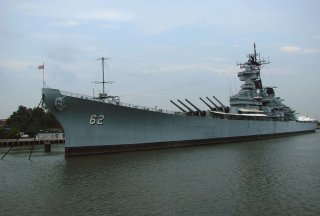This Battleship Fired 5,688 Massive 16-Inch Shells During Vietnam
New Jersey was on the gun line in South Vietnam for 120 days. She participated in the U.S. Navy’s Operation Sea Dragon, an effort to disrupt North Vietnam’s seagoing supply effort, shell coastal batteries and radar sites.
Here's What You Need To Remember: Bombarding targets from the safety of a battleship was much easier than bombing them from aircraft. The North Vietnamese, who had a sophisticated anti-aircraft network, had almost nothing that could target the USS New Jersey.
The U.S. Navy, concerned by aircraft losses in the air campaign against North Vietnam, saw the battleship as a low-risk way of bombarding coastal targets without losing aircraft and pilots. North Vietnam, other than tactical aircraft and torpedo boats, had little that could damage a battleship parked off its coastline.
As the war in Vietnam reached its crescendo, the U.S. Navy prepared to recommission one of the most powerful ships ever to serve in the fleet. USS New Jersey, an Iowa-class battleship, was reactivated to provide naval gunfire support for American and allied forces fighting in South Vietnam. The battlewagon fired nearly twenty thousand shells during its tour of duty, bombarding enemy forces the way only a battleship can.
The USS New Jersey was the second Iowa-class battleship ever built, and the third from last U.S. Navy battleship ever built. New Jersey was part of the Navy’s prewar rearmament program, as the United States began to build up its forces in response to war in both Europe and the Pacific. Construction began at the Philadelphia Naval Yard on September 16, 1940, and the ship was launched exactly one year after Pearl Harbor on December 7, 1942. She was finally commissioned into the U.S. Navy on May 23, 1943.
New Jersey was built to the same specifications as her three sister ships: Iowa, Missouri, and Wisconsin. (Two additional ships, Illinois and Kentucky, were ordered but never completed.) Each battleship was 860 feet long, weighed 57,350 tons fully loaded with ammunition and fuel, and were powered by four General Electric steam turbines, giving them a top speed of 33 knots. The battleships were armed with nine sixteen-inch guns, twenty five-inch dual purpose guns, eighty 40-millimeter anti-aircraft guns, and forty nine 20-millimeter anti-aircraft guns.
The Ohio-class battleships were originally designed to duke it out with other battleships, including such Axis ships as the German Bismarck and the Japanese super-battleships Yamato and Musashi. The changing nature of warfare, however, relegated the battleships to providing naval gunfire support for Army and Marine landings across the Pacific and anti-air warfare escort for aircraft carriers. All four briefly saw action in the Korean War, with Iowa, New Jersey, and Wisconsin all reactivated to provide heavy gunfire support from the sea. The Korean War ended in 1953 and New Jersey was again decommissioned in 1957.
In 1968 New Jersey was brought out of mothballs yet again, for yet another war. New Jersey was recommissioned on April 6, 1968 at the Philadelphia Naval Shipyard where she had been built a quarter century before. The battleship had only a modest set of modifications: her 40-millimeter guns were removed and a helicopter landing pad was added. The ship was also fitted with SHORTSTOP, a brand new combined jammer and chaff launcher meant to protect the ship from radar-guided anti-ship missiles.
The U.S. Navy, concerned by aircraft losses in the air campaign against North Vietnam, saw the battleship as a low-risk way of bombarding coastal targets without losing aircraft and pilots. North Vietnam, other than tactical aircraft and torpedo boats, had little that could damage a battleship parked off its coastline. A battleship could provide responsive fire support day or night, rain or shine, whenever friendly forces needed it.
USS New Jersey departed Philadelphia on May 16, 1968, traveling down the East Coast and passing through the Panama Canal before arriving at her new home port of Long Beach. The ship fired her guns, including the sixteen-inch guns off San Clemente Island in June 1968, then proceeded to Hawaii and then Subic Bay, the Philippines.
The battleship finally arrived off the coast of Southeast Asia on September 29th, 1968, and fired her guns in anger again for the first time in over fifteen years the next day. New Jersey was on the gun line in South Vietnam for 120 days. She participated in the U.S. Navy’s Operation Sea Dragon, an effort to disrupt North Vietnam’s seagoing supply effort, shell coastal batteries and radar sites. As originally intended, New Jersey was able to relieve U.S. tactical air forces from missions near the enemy coastline. The battleship also responded to calls for fire from the 1st and 3d Marine Divisions, 173rd Airborne Brigade, and 101st Airborne Division.
Over the course of her relatively short Vietnam patrol New Jersey fired 5,688 16-inch gun rounds and 14,891 five-inch gun rounds, far more than she fired during World War II and the Korean War combined. She was never seriously attacked by North Vietnamese forces.
After her Vietnam tour the ship returned to Long Beach. During the workup to her second tour her crew learned that the ship was scheduled to once again go into mothballs, the victim of cost cutting. Even a draftee military found it difficult to financially support a ship with 1,600 crew members and the demands of both Vietnam and the Cold War to satisfy.
New Jersey was inactivated in 1969. The old battlewagon would be reactivated just twelve years later as part of an effort to bring the U.S. Navy battle fleet up to 600 ships. USS New Jersey is now moored in Camden, New Jersey, where she serves as a floating museum.
Kyle Mizokami is a writer based in San Francisco who has appeared in The Diplomat, Foreign Policy, War is Boring and The Daily Beast. In 2009 he co-founded the defense and security blog Japan Security Watch. This article first appeared several years ago.
Image: Wikimedia Commons.

